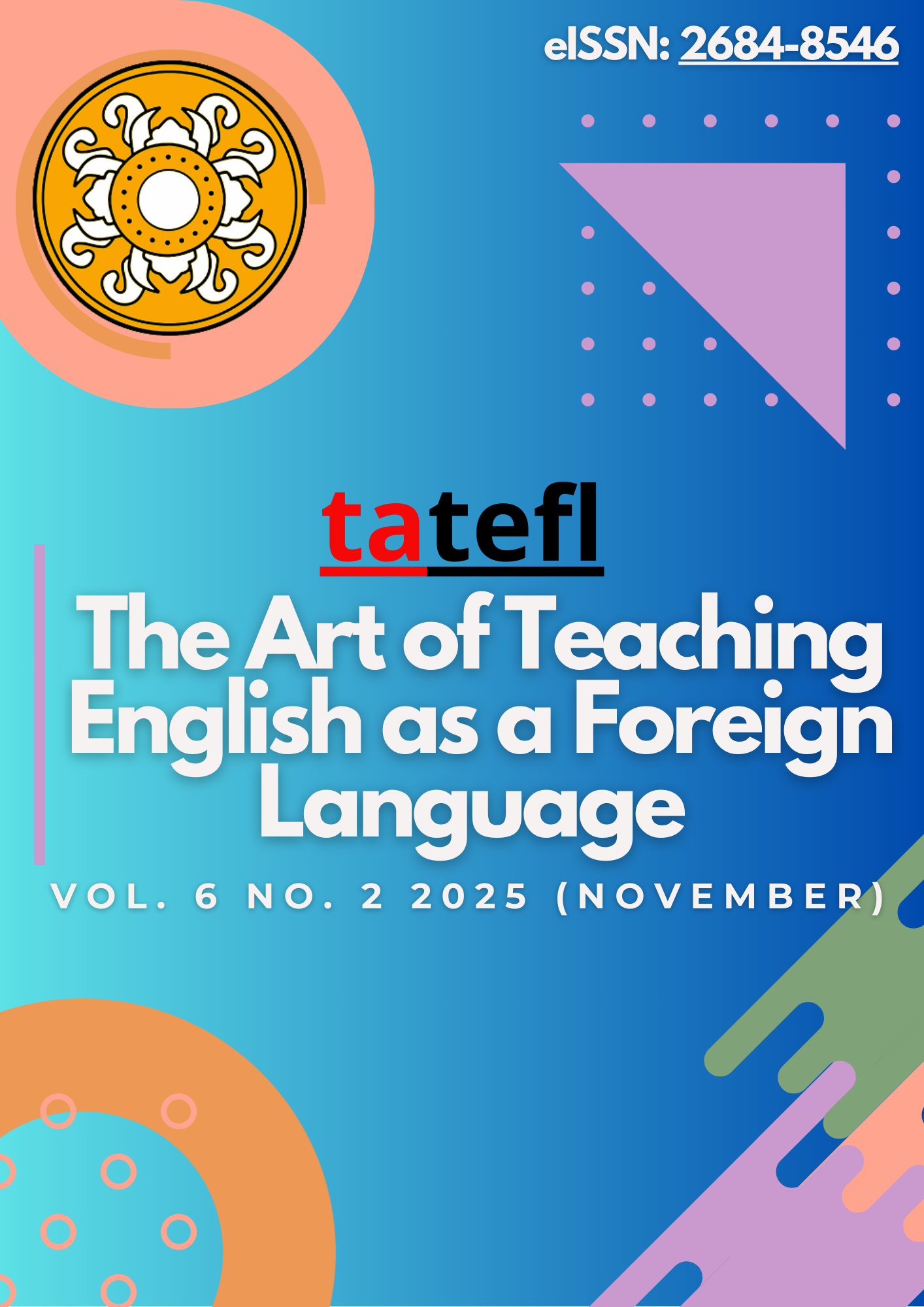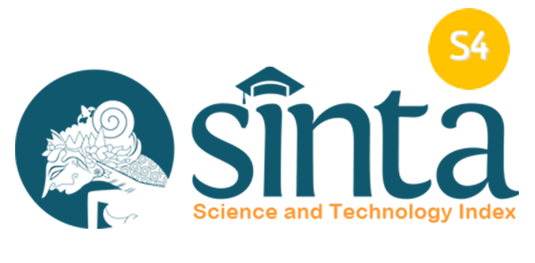Communication Strategies by English Lecturers and Class Coordinators: An Analysis of Hofstede's Cultural Dimensions
DOI:
https://doi.org/10.36663/tatefl.v6i2.967Keywords:
Communication strategies, Cultural dimension, English, WhatsApp, HofstedeAbstract
This study aims to classify the communication strategies used by English lecturers and class coordinators in WhatsApp messages and describe how class coordinators respond to English lecturers' communication strategies in the context of Hofstede's cultural dimensions. This research method uses qualitative descriptive. The instrument in this study is document analysis in the form of screenshots of English Lecturer and Class Coordinator. Data analysis in this study used six steps: (1) Data organization and preparation, (2) Preliminary reading of Data, (3) Data Coding, (4) Developing themes and categories, (5) Detailed analysis and representation, (6) Interpretation of findings. The results of the analysis based on Hofstede's cultural dimensions show that English lecturers generally respond to messages in a relaxed and concise manner, while class coordinators use a more polite and formal tone in their communication. These findings reveal clear differences in communication styles, reflecting the hierarchical dynamics inherent in the educational environment. This study contributes to the understanding of communication practices in academic settings, emphasizing the influence of cultural dimensions on interaction strategies.
Downloads
References
Adnyani, N. L. P. S. (2011). Introducing target language culture through movie watching and discussion. Jurnal Pendidikan dan Pengajaran, 44(1), 77-83.
Al-Samarraie, H., Teng, B. K., Alzahrani, A. I., & Alalwan, N. (2018). E-learning continuance satisfaction in higher education: a unified perspective from instructors and students. Studies in Higher Education, 43(11), 2003–2019. https://doi.org/10.1080/03075079.2017.1298088 DOI: https://doi.org/10.1080/03075079.2017.1298088
Arniati, M., Budasi, I. G., Lin, D. A., & Ramendra, D. P. (2013). An Analysis of Communication Strategies Used in Ngidih Wedding Ceremony in Sawan Village. Jurnal Pendidikan Bahasa Inggris Undiksha, 1(1).
Arthana, I. K. R., Dantes, G. R., & Dantes, N. (2018). Optimalisasi pemanfaatan teknologi informasi dan komunikasi (tik) dalam bidang pendidikan melalui penerapan smart school. Jurnal Widya Laksana, 7(1), 81–91.
Ashiyan, Z., & Salehi, H. (2016). A comparison of male and female learners' English collocation learning through WhatsApp. International Journal of Research Studies in Educational Technology, 6(1), 25–42. https://doi.org/10.5861/ijrset.2016.1615 DOI: https://doi.org/10.5861/ijrset.2016.1615
Bowen, G.A. (2009). Document analysis as a qualitative research method. Qualitative Research Journal, 9(2), 27-40. https://doi.org/10.3316/QRJ0902027 DOI: https://doi.org/10.3316/QRJ0902027
Brophy, J. (2004). Motivating students to learn (2nd ed.). Lawrence Erlbaum Associates Publishers. DOI: https://doi.org/10.4324/9781410610218
Church, K., & De Oliveira, R. (2013). What is up with WhatsApp? Comparing mobile instant messaging behaviours with traditional SMS. MobileHCI 2013 - Proceedings of the 15th International Conference on Human-Computer Interaction with Mobile Devices and Services, 352–361. https://doi.org/10.1145/2493190.2493225 DOI: https://doi.org/10.1145/2493190.2493225
Creswell, J. W. (2009). Editorial: Mapping the field of mixed methods research. Journal of Mixed Methods Research, 3(2), 95–108. https://doi.org/10.1177/1558689808330883 DOI: https://doi.org/10.1177/1558689808330883
Dai, Y., Li, H., Xie, W., & Deng, T. (2022). Power distance belief and workplace communication: The mediating role of fear of authority. International Journal of Environmental Research and Public Health, 19(5). https://doi.org/10.3390/ijerph19052932 DOI: https://doi.org/10.3390/ijerph19052932
Dantes, G. R., Suarni, N. K., Dharsana, I. K., Dantes, N., Jayanta, I. N. L., Suwastini, N. K. A., & Putra, G. J. A. (2019). Evaluation of e-learning as a learning agent. International Journal of Innovation and Learning, 25(4), 451-464. https://doi.org/10.1504/IJIL.2019.099989 DOI: https://doi.org/10.1504/IJIL.2019.099989
Dantes, G. R., Suarni, N. K., Suputra, P. H., Suwastini, N. K. A., & Jampel, I. N. (2017). Face-expression detection: Detection of facial expression for optimizing the role of the e-learning system. In Regionalization and Harmonization in TVET (1st Editio, pp. 289– 292). https://doi.org/10.1201/9781315166568-61 DOI: https://doi.org/10.1201/9781315166568-61
Eagly, A. H., & Wood, W. (2012). Social role theory of sex differences in social behaviour. In Handbook of Theories of Social Psychology. https://doi.org/10.1002/9781118663219.wbegss183 DOI: https://doi.org/10.1002/9781118663219.wbegss183
Farida, F., & Yuliana, D. (2019). Politeness xtrategies in WhatsApp text messaging between sundanese students and lecturers. Proceedings of the Second Conference on Language, Literature, Education, and Culture (ICOLLITE 2018). https://doi.org/10.2991/icollite-18.2019.37 DOI: https://doi.org/10.2991/icollite-18.2019.37
Fatehi, K., Priestley, J. L., & Taasoobshirazi, G. (2020). The expanded view of individualism and collectivism: One, two, or four dimensions?. International Journal of Cross-Cultural Management, 20(1), 7–24. https://doi.org/10.1177/1470595820913077 DOI: https://doi.org/10.1177/1470595820913077
Febrianti, M., & Yuneva, Y. (2023). An analysis of students’ politeness strategies in Whatsapp group interaction. Edu-Ling: Journal of English Education and Linguistics, 6(2), 206–215. https://doi.org/10.32663/edu-ling.v6i2.3508 DOI: https://doi.org/10.32663/edu-ling.v6i2.3508
Gannouni, K., & Ramboarison-Lalao, L. (2019). Examining gender effects on leadership among future managers: Comparing Hofstede’s masculine vs. feminine countries. Management international, 23, 42–51. https://doi.org/10.7202/1068534ar DOI: https://doi.org/10.7202/1068534ar
Gelfand, M. J., Lim, B. C., & Raver, J. L. (2004). Culture and accountability in organizations: Variations in forms of social control across cultures. Human Resource Management Review, 14(1), 135–160. https://doi.org/10.1016/j.hrmr.2004.02.007 DOI: https://doi.org/10.1016/j.hrmr.2004.02.007
Ghosh, A. (2011). Power distance in organizational contexts review of collectivist cultures. Indian Journal of Industrial Relations, 47(1), 89–101.
Hofstede, G. (2011). Dimensionalizing Cultures: The Hofstede model in context.. Online Readings in Psychology and Culture, 2(1), 1–26. https://doi.org/10.9707/2307-0919.1014 DOI: https://doi.org/10.9707/2307-0919.1014
Hofstede, G., & Minkov, M. (2010). Long- versus short-term orientation: New perspectives. Asia Pacific Business Review, 16(4), 493–504. https://doi.org/10.1080/13602381003637609 DOI: https://doi.org/10.1080/13602381003637609
Hussein, S. F. F., Rashid, R. A., Azizan, M., & Alali, O. M. M. (2023). A discourse analysis of teachers’ messages in official and unofficial WhatsApp groups. Frontiers in Communication, 7. https://doi.org/10.3389/fcomm.2022.1064186 DOI: https://doi.org/10.3389/fcomm.2022.1064186
Keswani, A., Medhat, M., Miguel, A. F., & Ramos, S. B. (2020). Uncertainty avoidance and mutual funds. Journal of Corporate Finance, 65. https://doi.org/10.1016/j.jcorpfin.2020.101748 DOI: https://doi.org/10.1016/j.jcorpfin.2020.101748
Lawrie, S. I., Eom, K., Moza, D., Gavreliuc, A., & Kim, H. S. (2020). Cultural variability in the association between age and well-being: The role of uncertainty avoidance. Psychological Science, 31(1), 51–64. https://doi.org/10.1177/0956797619887348 DOI: https://doi.org/10.1177/0956797619887348
Limajatini, L., Murwaningsari, E., & Khomsiyah, K. (2019). Analysis of effect of power distance, power avoidance, individualism, masculinity and time orientation toward auditing behavior with mediation of locus of control. ECo-Fin, 1(1), 12–21. https://doi.org/10.32877/ef.v1i1.53 DOI: https://doi.org/10.32877/ef.v1i1.53
Maharani, W. W., Arasuli, A., & Kurniawan, I. (2022). The forms of politeness applied by English students in communication to their thesis advisor lecturers via WhatsApp. Journal of English Education and Teaching, 6(3), 417–432. https://doi.org/10.33369/jeet.6.3.417-432 DOI: https://doi.org/10.33369/jeet.6.3.417-432
Milosevic, D. (2019). A comparison of Hofstede Cultural Dimensions: Italy, Germany and Serbia. The Economic and Management of Natural Resources.
Mohamed, Z. A., & Unsalan, M. (2025). The effect of Hofstede cultural dimensions on brand equity: The mediating role of perceived usefulness. Pazarlama Ve Pazarlama Araştırmaları Dergisi, 18(1), 141-168. https://doi.org/10.15659/ppad.18.1.1414678 DOI: https://doi.org/10.15659/ppad.18.1.1414678
Mudita, I. K., Seken, I. K., & Kusuma, I. P. I. (2017). an analysis of communication strategies used by freelance guides in Ubud tourism object. Jurnal Pendidikan Bahasa Inggris Undiksha, 5(2).
Mulyanah, A., & Krisnawati, E. (2022). Cross-cultural communication of foreign students in the Indonesian language regarding cultural expressions. International Journal of Science and Applied Science: Conference Series, 6(2), 2549–4635. https://doi.org/10.20961/ijsascs.v6i2.73914 DOI: https://doi.org/10.20961/ijsascs.v6i2.73914
Polat, H. H. (2019). Impact of cultural dimensions on individualism and collectivism dimension. Journal of Business and Economics, 10(12), 1154–1164. https://doi.org/10.15341/jbe(2155-7950)/12.10.2019/003 DOI: https://doi.org/10.15341/jbe(2155-7950)/12.10.2019/003
Rahman, A., & Isroyana, D. N. (2021). Communication strategies used by EFL students in English classroom setting. Jo-ELT (Journal of English Language Teaching), 8(2), 207. https://doi.org/10.33394/jo-elt.v8i2.4482 DOI: https://doi.org/10.33394/jo-elt.v8i2.4482
Rosaline, A., Syafri, F., & Sakhiyya, Z. (2023). Communication strategies in synchronous and asynchronous media. English Education Journal, 13(1), 29–38. https://doi.org/10.15294/eej.v13i1.70279 DOI: https://doi.org/10.15294/eej.v13i1.70279
Saepudin, D. (2023). Implementation of lecturer communication strategies in building student understanding of PTNBH at the Bandung Institute of Technology (ITB) West Java. Manazhim, 5(1), 417–433. https://doi.org/10.36088/manazhim.v5i1.2970 DOI: https://doi.org/10.36088/manazhim.v5i1.2970
Shalihah, M., & Winarsih, T. (2023). Politeness strategies in WhatsApp text messaging. International Journal of Social Science Research and Review, 6(7), 137-151 https://doi.org/10.47814/ijssrr.v6i7.1323 DOI: https://doi.org/10.47814/ijssrr.v6i7.1323
Usman, J., Zainuddin, Z., Zulfikar, T., Lugendo, D., & Yusuf, Y. (2022). When online learning and cultural values intersect: Indonesian EFL students’ voices. Issues in Educational Research, 32(3), 1196–1212.
Utami, L. P. R. A., Suwastini, N. K. A., Dantes, G. R., Suprihatin, C. T., & Adnyani, K. E. K. (2021). Virtual reality for supporting authentic learning in 21st-century learning. Jurnal Pendidikan Teknik dan Kejuruan, 18(1), 132–141. https://doi.org/10.23887/jptk-undiksha.v18i1.32376 DOI: https://doi.org/10.23887/jptk-undiksha.v18i1.32376
Vu, N. T., & Tran, N. M. H. (2022). Synchronous Online learning in higher education: Vietnamese university students’ perspectives. Journal of Ethnic and Cultural Studies, 9(1), 131–160. https://doi.org/10.29333/ejecs/970 DOI: https://doi.org/10.29333/ejecs/970
Yuliawati, S. N., Hazma, & Bakhti, K. Y. (2020). The Characteristics of Language Politeness in Students’ WhatsApp Messages to Lecturers. Proceedings of the 4th International Conference on Arts Language and Culture (ICALC 2019), 506–511. https://doi.org/10.2991/assehr.k.200323.058 DOI: https://doi.org/10.2991/assehr.k.200323.058
Downloads
Published
How to Cite
Issue
Section
License
Copyright (c) 2025 Kadek Mahardika, Ni Luh Putu Sri Adnyani, Dewa Putu Ramendra

This work is licensed under a Creative Commons Attribution-ShareAlike 4.0 International License.
License Terms
- Attribution — You must give appropriate credit, provide a link to the license, and indicate if changes were made. You may do so in any reasonable manner, but not in a way that suggests the licensor endorses you or your use.
- ShareAlike — If you remix, transform, or build upon the material, you must distribute your contributions under the same license as the original.
- No additional restrictions — You may not apply legal terms or technological measures that legally restrict others from doing anything the license permits.

















